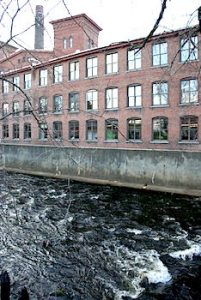The SWI extends its congratulations to the Historical Society of Glastonbury, CT for raising funds to save and restore the stone walls of Hopewell Mills, located on Roaring Brook. For the full story, consult the July 6 story in the Hartford Courant.
Such mills are testimony to the adaptability and innovation of America’s energy use. Fully ten percent of America’s energy now comes from renewables, ethanol are on the wane, nuclear is being re-thought, fossil fuels are slowly being phased out, and hydropower has fallen into the shadows. Building them required stone, and lots of it. Hence, stone walls played an critical role in America’s energy policy, especially in the decades prior to the Civil War.
However, there was a time in American history when hydropower was king, and when manufacturing was totally dependent on it. Largest was in Lowell, Massachusetts where “the controlled flow of water turned 31 mills, 6,300 looms, and 225,000 thread spindles” in a city created at a hydropower site on the Merrimack River.* Even there, in the rush to embrace coal, those plants turned to steam and let the water go by. Eventually most of these mills closed as America’s energy policy moved towards coal, and then petroleum, and now gas.
Such mills nucleated communities all across America, concentrating people, especially recent immigrant workers, in ways that would not be repeated again.
*Quote from my recent book, The Boatman (Cambridge, MA: Harvard Press, 2014), 214. This sources Theodore Steinberg’s Nature Incorporated: Industrialization and the Waters of New England (New York: Cambridge University Press, 1991).
The photo above is from Maynard, MA.
